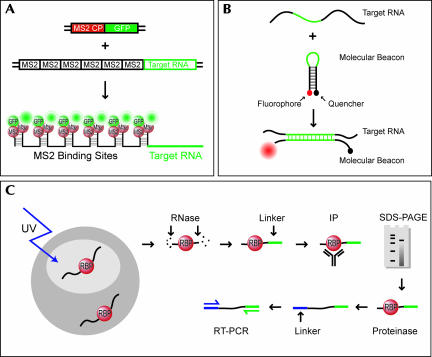FIGURE 1.
Schematics of zipcode identification strategies. (A) in vivo GFP-RNA tagging (after Bertrand et al. 1998). The RNA of interest is expressed fused to a reporter containing six tandem repeats of the MS2 stem–loop sequence. An MS2-coat protein–GFP fusion is coexpressed, resulting in a GFP-marked RNA. (B) Molecular beacons (after Bratu et al. 2003). A hairpin oligonucleotide containing sequences complementary to the target RNA is conjugated to a fluorophore at one end and a quencher at the other. In the hairpin conformation, the fluorophore is quenched. Upon injection of the molecular beacon into cells and subsequent hybridization to the target RNA, the quencher is removed from the proximity of the fluorophore and the RNA can be tracked based on a signal from the fluorophore. (C) CLIP (after Ule et al. 2005). RNA–protein complexes are cross-linked with UV, isolated, and treated with Rnase. Protein-bound RNA regions are protected from digestion. A linker is ligated to the 3′ end, and intact complexes are isolated by immunoprecipitation of the RNA-binding protein, followed by SDS-PAGE purification. The protein is then removed by digestion. A second linker is ligated to the 5′ end and the isolated RNA is amplified by reverse transcription and PCR.

